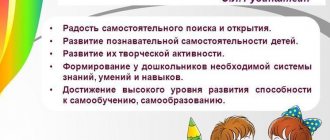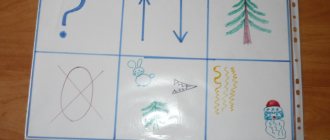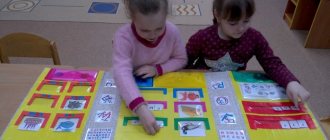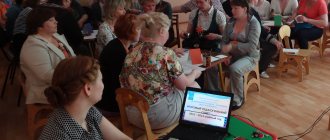MAGAZINE Preschooler.RF
Visual modeling as an effective means of mental development of preschool children- Kharchenko Anna Vladimirovna, Teacher of the Irkutsk Municipal Budgetary Educational Institution, Kindergarten No. 75;
- Shatokhina Marina Gennadievna, Teacher of the Irkutsk Municipal Budgetary Educational Institution, Kindergarten No. 75
The modern world is changing very quickly. Everything changes along with it, including thinking. The task of today's students is not simply to acquire knowledge, but to be able to obtain it independently and operate with it. Therefore, modern pedagogy is looking for opportunities to use the hidden reserves of children’s mental activity, ways of the most effective learning. The learning process, of course, should be as visual and as dynamic as possible. It should be noted that one of these ways to develop children's interest in learning is modeling.
Modeling is a visual and practical teaching method. A model is a generalized image of the significant properties of the object being modeled (room plan, geographic map, globe, etc.). The modeling method was developed by D. B. Elkonin, L. A. Wenger, N. A. Vetlugina, N. N. Poddyakov. Its essence lies in the development of a child’s thinking with the help of special schemes, models, which in a visual and accessible form reproduce the hidden properties and connections of a particular object.
In preschool pedagogy, there are three types of models:
- Subject model. This can be a physical structure, an object or objects that are naturally connected with each other. The model is an analogue of the object and reproduces its main connections and features.
- Subject-schematic model. In this case, essential components and connections between them are indicated using substitute objects and graphic signs. This model shows connections in a generalized form.
- Graphic model. Generally conveys different types of relationships, represents a graph, diagram, map, etc.
Visual modeling techniques include: substituents, pictograms, mnemonic tables.
In substitution, some objects are replaced by others. As a rule, paper squares, circles, ovals, different in color and size, are used as substitutes, since the substitution is based on some difference.
A pictogram is a symbolic image that replaces a word. This modeling technique refers to non-verbal means of communication and can be used in the following cases:
- when the child does not yet speak, but will soon master speech;
- for constant communication with a child who is unable to speak at all;
- to facilitate speech development;
- as preparation for mastering writing and reading;
- as a means of helping to express thoughts orally.
Mnemonic tables are diagrams that contain some information. The essence of the mnemonic diagram is this: for each word or small phrase you need to come up with some kind of picture; thus, the entire text is sketched schematically. The child will remember information much faster by looking at these diagrams and drawings. Therefore, we can say that mnemonic diagrams are a kind of memorization tool.
Many researchers believe that the modeling method can be used in various types of children's activities (N. N. Kondratyeva, M. V. Krulekht, A. K. Matveeva, T. D. Richterman, O. N. Somkova, etc.).
Indeed, modeling can be used everywhere - in mathematical and speech development, when familiarizing with fiction, in visual arts and when getting to know the world around us. The teacher is always looking for new ways and techniques that help make it easier for children to learn new material. Visual modeling is an excellent teacher’s assistant. It develops cognitive interest, teaches children to highlight the main idea, systematize their knowledge, and also helps prevent fatigue.
Using the visual modeling method in preschool education is very effective. After all, children understand various schematic images easily and quickly and use them successfully in the future. Older preschoolers only need one explanation to understand what a floor plan is, and they will freely find an object hidden in the room, focusing on the marks on the plan. Children easily recognize schematic representations of objects, use a map-type diagram to choose the right path in an extensive system of paths, etc.
It is known that it is easier for a child to learn many types of knowledge in the form of actions with models, rather than on the basis of a verbal explanation from an adult. For example, when forming mathematical concepts, it is extremely difficult for children to become familiar with the relationships between the part and the whole. Verbal methods in this case are not as effective as schematic images: when using visual modeling, children easily understand that a whole object can be divided and restored from parts.
What goals should a teacher pursue when using visual modeling in his work? First of all, develop cognitive interest, teach children to independently obtain information. The visual modeling method allows preschoolers to conduct research, make comparisons, and draw conclusions.
Practice shows that the use of modeling helps children easily navigate the sign system and coding methods, improves oral speech, promotes the development of logical and figurative thinking, memory, and attention. It also forms ideas about the world around us, work, etc.
Thus, we can say that modeling is one of the most effective methods of mental education of preschool children, since their thinking is characterized by objective imagery and visual concreteness. Therefore, it is possible and necessary to use the modeling method in the practice of preschool education. Teachers should not be afraid to use this technique, as it produces tangible results.
| Next > |
Teacher portal
Author:
Ekaterina Andreevna Pushina
Position:
teacher
Educational institution:
MBDOU No. 1 “Cheburashka”
Settlement:
Ust-Ilimsk, Irkutsk region
Name of material:
Article
Topic:
“Visual modeling technology in practice in preschool educational institutions”
Date of publication:
03/16/2016
Section :
preschool education
Topic: “Visual modeling technology in practice in preschool educational institutions”
Relevance:
In our dynamic age, the flow of information has increased significantly.
Accordingly, the process of perceiving this information has become more complicated. Leading specialists in preschool education N.N. Podyakova rightly emphasized that at the present stage it is necessary to give children the key to understanding reality, and not strive for exhaustive information. In preschool pedagogy, a model can become a tool of cognition. Preschoolers are deprived of the opportunity to record information or note anything in writing in class, so in kindergarten mainly one type of memory is involved - verbal. Modeling
is an attempt to use visual, motor and associative memory to solve cognitive problems. This is an optimal and effective technology that allows you to maximize speech activity while maintaining interest in the lesson.
The accessibility of modeling to preschoolers was also noted in the studies of L.A. Wenger, D.B. Elkonina. Modeling is based on the principle of substitution, where real objects are replaced by a drawing, diagram, or icon. Therefore, the relevance is that:
1-preschooler is flexible, easy to teach, but quickly gets tired and loses interest.
Modeling arouses interest and thereby solves this problem. 2- The use of analogy symbols facilitates and speeds up the memorization process. But one of the rules of memorization says: “When you learn, write down, draw, damn it!” 3-Graphic analogies help to see the main thing and systematize the acquired knowledge. Thus, modeling is a visual, practical teaching method developed by D.B. Elkonin, N.N. Podyakova, N.A. Vetlugina. It lies in the fact that the child’s thinking develops with the help of special schemes, models, which in a visual and accessible form reproduce the hidden properties and connections of a particular object. The formation of visual modeling skills occurs with a constant increase in the share of children’s independent participation in the work process. This technology has variability, flexibility, and versatility, since the conventions are easily perceived by children. Pictograms and diagrams used in the work. Mnemonic tables, icons-symbols, stylized pictures, graphs, plans not only activate children. But they also contribute to the transfer of speech skills from the “zone of proximal development” to the “zone of actual development.” At preschool age, various types of models are used:
object models - in which design features, proportions, and the relationship of parts of any objects are reproduced.
These can be models of buildings, a globe, an ecosystem. Subject-schematic models - they contain features, connections, relationships, presented in the form of model objects. Examples include algorithms, sequences of actions (washing, serving, caring for plants. Cooking technologies, logorhythmic exercises) Graphic models (graphs, diagrams) convey conditionally generalized features, connections, relationships. Phenomena. An example would be the “Weather and Nature Calendar”, a plan for a group, a site, a doll’s corner, or a travel route. During visual modeling, children are introduced to a graphical method of transmitting information - a model. Geometric figures, symbolic images, plans can act as conditional substitutes (elements of the model). By obtaining information using the method of visual modeling, children learn:
to explore, compare, draw up an internal plan of mental actions, and improve speech functions.
- Form and express judgments and conclusions. The use of visual modeling has a positive impact on the development of not only speech processes, but also non-speech ones: attention, memory, thinking. Visual modeling technologies require compliance with the following teaching principles: developmental and educational nature of training; - systematicity and consistency; - consciousness and independence; - creative activity; - visibility and accessibility; - a combination of collective and individual work. The formation of visual modeling skills occurs in the following stages: - assimilation and analysis of sensory material; translation into sign-symbolic language; - work with the model. The stages of developing visual modeling skills solve the following
problems:
1. Familiarity with the graphical method of providing information.
2. Formation of the skill of decoding the model. H. Formation of independent modeling skills. At school, the sign-symbolic system is constantly used. With its help, children are taught to encode the information being studied. This is a necessary component of learning, and correct speech is one of the indicators of a child’s readiness for school, the key to successful literacy and reading. Our introduction of visual modeling into the learning process in our group allowed us to purposefully develop speech, enrich the vocabulary, consolidate new word formation, form and improve the ability to use various sentence structures in speech, describe objects, and compose stories. Retelling, correct use of prepositions. At the initial stages of our work on introducing visual modeling, we used the following material: pictures, objects, stylized images that provide support for visual-figurative thinking, which corresponded to the initial stage of learning - mental operations: synthesis, analysis, classification. At the next stage, more complex operations were used - generalization, abstractions, where visual models were based on both figurative and verbal-logical thinking, that is, a speech pattern. Methods of visual modeling in our group include:
designating objects using a variety of substitutes;
use and creation of different types of conditional diagrams, images of real objects and objects; ability to read and create graphic images of signs. Objects belonging to one or another class (clothing, shoes, fruits, vegetables, etc.) the ability to navigate in space according to a diagram; the ability to draw up a plan of real space (room, group, area.) the ability to use space-time models when retelling, composing a story; independent creation of models according to your own plans. Thus, visual modeling is used in all types of children's activities and in all educational areas, because it is a source of development of mental abilities and creativity in preschool childhood. At this age, the development of imagination and imaginative thinking is the main direction of mental development. We mostly use modeling in classes on teaching coherent speech, literacy, cognition, artistic activity, labor, experimental activities, independent, gaming, music, physical education, but of course taking into account age characteristics. Stages of introducing visual modeling into practice:
Stage 1 - teach how to read tables: a.
providing information on a topic in the form of an educational conversation; b. viewing the finished table. Compiled according to the content of the topic, decoding of symbols, decoding of information; V. retelling information by children based on a diagram with and without the help of an adult; d. graphic sketches of diagrams, mnemonic tables based on the results of activities. Stage 2: introduce general models of encoding information about objects, objects, and phenomena. a.topic message; b. consideration of the general encoding scheme (the material for this is any generalizing concept: animals, sense organs, transport, trees, etc.) c. drawing up a model of information about a specific topic based on a general scheme. Modeling is carried out under the guidance of an adult using guiding questions. What does this sign mean? What can we tell you about this object? How do we represent this in our model? Guessing riddles - mnemonic tables compiled by the teacher based on the general scheme. Stage 3: joint coding of information, discussion of variants of signs reflecting one or another property of the item being coded, and independent creation of tables based on the material covered. Stage 4: practicing coding skills in different types of activities. With the help of a pictorial and graphic plan, presented in the form of pictograms and object pictures, children retell texts, learn riddles, compose stories, sketch the texts of riddles, quatrains, and short stories. A set of pictograms allows you to show the diversity of words with the same root, and the drawing shows the direction of thoughts. The most positive thing about using pictograms is that the teacher’s speech is reduced to a minimum. Pictograms can be changed and supplemented. It all depends on the creativity of the teacher. At the initial stage of learning to compose descriptive stories, we made a diagram from individual cards, substituting them one by one for the object being described, and then gradually moving them away from each other and finally combining them into a single cell diagram (mnemonic table.) The use of mnemonic tables has a positive effect:
1 Visual thinking develops powerfully; 2. stable attention and long-term concentration are developed; 3. the ability for effective independent learning is formed. Thus, with the help of visual modeling, the following results can be achieved: 1. there will be an interest in memorizing poetry, logorhythmic exercises, finger gymnastics; 2. vocabulary will increase; Z. children will overcome shyness, timidity, and the acquired skill will help them to hold themselves freely and speak out in front of an audience. An increased sense of interest, satisfaction with their answers, the results of their work improve the child’s psychological processes: memory, attention, thinking, speech, which has a positive effect on the results of correctional education. work.
Consultation for educators “Modeling method in the educational process of preschool educational institutions”
MDOU kindergarten No. 47 “Veterok”
Consultation for educators
“Modeling method in the educational process of preschool educational institutions”
“Modeling method in the educational process of preschool educational institutions”
1.Modeling and its essence.
2. Requirements for models.
4. Methodological recommendations for introducing models into the educational process.
5.Use of the modeling method in various types of children's activities.
Modeling –
the process of creating models and their use in order to generate knowledge about the properties, structure, relationships, connections of objects. The peculiarity of modeling as a teaching method is that it makes visible the properties, connections, relationships of objects that are hidden from direct perception, which are essential for understanding facts, phenomena, in the formation of knowledge that is close in content to concepts.
The accessibility of the modeling method for preschoolers was shown by psychologists (A.V. Zaporozhets, L.A. Venger, N.N. Poddyakov, D.B. Elkonin). It is determined by the fact that modeling is based on the principle of substitution: a real object can be replaced in children’s activities by another object, image, sign. Models have been developed for the formation of natural history knowledge, speech development, sound analysis of words, construction, visual activities, etc. (N.I. Vetrova, L.E. Zhurova, N.M. Krylova, V.I. Loginova, L.A. Paramonova, T.D. Richterman, etc.).
Requirements for the model
In order for a model as a visual and practical means of cognition to fulfill its function, it must meet a number of requirements:
1. clearly reflect the basic properties and relationships that are the object of cognition, be similar in structure to the object being studied. 2. be easy to understand and accessible to create and act with; 3. clearly and clearly convey those properties and relationships that must be mastered with its help; 4. it should facilitate cognition (M.I. Kondakov, V.P. Mizintsev).
In didactics there are three types
models:
1. Subject model -
has the appearance of a physical structure of an object or objects that are naturally connected. In this case, the model is similar to the object, reproducing its main parts, design features, proportions and relationships of parts in space, and the interconnection of objects. What distinguishes such a model from a toy is the accuracy of its reproduction of essential connections and dependencies within the modeled object or between them, and the ability to detect these dependencies in activities with the model.
2. Subject-schematic model. —
Here, the essential components and connections between them identified in the object of cognition are indicated using substitute objects and graphic signs. The structure of such a model should be similar to the main components of the object being studied and to those connections and relationships that become the subject of cognition. The subject-schematic model should detect these connections and clearly present them in an isolated, generalized form.
3.Graphic models. —
Different types of relationships are conveyed in a generalized manner (graphs, formulas, diagrams). This type of model is used mainly in school.
Guidelines for introducing models
into the educational process
The methodology for introducing models into the cognition process must take into account a number of circumstances:
1.
The model, revealing the connections and relationships necessary for cognition, simplifies the object, representing only its individual aspects, individual connections. Consequently, the model cannot be the only method of cognition: it is used when it is necessary to reveal for children this or that essential content in an object. This means that the condition for introducing models into the process of cognition is the preliminary familiarization of children with the real objects, phenomena themselves, their external features, specifically represented connections and mediations in the surrounding reality.
2.
The introduction of a model requires a certain level of development of mental activity: the ability to analyze and abstract the features of objects and phenomena; imaginative thinking that allows you to replace objects; ability to establish connections. And although all these skills are formed in children in the process of using models in cognitive activity, introducing them, mastering the model itself and using it for further cognition requires a level of differentiated perception, imaginative thinking, coherent speech and a rich vocabulary that is already quite high for a preschooler.
3.
Using a model to understand the essential features of objects requires children to first master the model. At the same time, children master simple object models quite quickly. More complex connections require more complex subject-schematic models and special techniques. In this case, children are first involved in the process of creating a model, which is linked to the observation and analysis of the modeled phenomenon. This allows the child to identify the components of the object being analyzed and to master what will then be subject to analysis in their model. Thus, the development of the model itself is presented in the form of children’s participation in creating the model, participation in the process of replacing objects with schematic images. This preliminary mastery of the model is a condition for its use to reveal the connection reflected in it.
Using the “modeling” method in various types of children's activities
1. Modeling in the mathematical development of children.
a) Dienesh’s logical blocks are a set of three-dimensional geometric shapes that differ in shape, color, size, and thickness. b) Cuisinaire sticks - a set of counting sticks of different colors and different lengths. Sticks of the same length are painted the same color and represent the same number. The longer the stick, the greater the value of the number it expresses. c) The modeling method in mathematics is often found in the form of “chains of symbols”. For example, combinations of symbols are used when orienting on a sheet of paper. d) You can also refer to reference diagrams when using abbreviations to designate months of the year.





